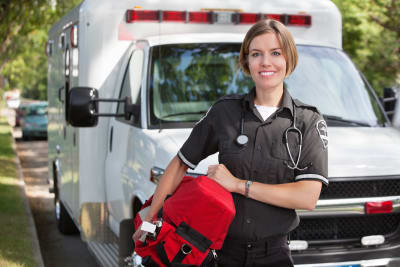By their very nature, emergencies are wildly unpredictable and can happen anywhere and to anyone. When they happen, there is usually a need for quick, decisive medical interventions that go a long way in mitigating the results of the disaster.
Since it is only sometimes feasible to get doctors to scenes of emergencies outside the hospital, there arose a need for medical technicians who would specialize strictly in emergency response. Thankfully, EMTs stood up to charge.
As you may have insinuated, EMTs, short for emergency medical technicians, are responsible for caring for sick and injured people who are subjects of medical emergencies.
EMT Duties
As an EMT, emergency response is always the priority. However, specific medical and social tasks tend to arise during the process. Their training allows them to deal with these situations much better than others.
Some of the tasks an EMT performs during emergency response include:
- Analyzing what state a patient is in as fast as possible
- Charting a decisive course of action for essential immediate treatment
- Giving first aid so that patients remain responsive
- Make subsequent treatment by physicians easier by sharing their observations and assessments on arrival
- Help move patients from one hospital to another
What Kinds of Emergencies Do EMTs Respond To?
EMTs respond to a wide range of medical emergencies. Their services may be required to help apply a bandage to a wound, perform CPR, or provide first-aid to vehicular accident victims.
EMTs typically respond to emergencies in ambulances. Thanks to movies and popular media, EMTs have become practically synonymous with ambulances. It should be noted, however, that EMTs can travel via other forms of transportation, including aircraft and boats, when necessary.
Types of EMTs
EMT is an umbrella term for a series of emergency medical responders who all fall into different categories. The categories are usually defined by training and certification, which in turn determines what a medical responder can and cannot do in a scene of an emergency.
We take a look at these categories below.
Emergency Medical Responders. EMRs
Emergency Medical Responders are the first category of EMTs and are also the most fundamental. Their duties are limited to immediate care to save patients’ lives in severe conditions.
There is a considerable limit to what an EMR can do on the scene. They do not act as primary caregivers and are often members of other agencies, such as medical reserve volunteers and firefighters.
EMRs do not have the knowledge required to transport patients to medical facilities. To be an EMR, you must complete an accredited program.
Regular EMTs
A tier above the EMRs are regular EMTs. Regular EMTs can provide primary lifesaving care just like EMRs but can also take it further through noninvasive intervention maneuvers.
They can also transport patients to medical facilities and handle most of the primary out-of-hospital care. EMTs must also complete accredited courses to become certified.
Advanced EMTs
Advanced EMTs, as the name implies, can carry out more advanced medical care during emergencies. While regular EMTs can only carry out noninvasive interventions, an advanced EMT may carry out invasive interventions to an extent.
To become an advanced EMT, you must have already become a regular EMT and completed another required course level.
Paramedics
At the highest level of capability for emergency medical technicians are paramedics. Unlike the rest of the categories, paramedics are capable of carrying out actual invasive interventions.
Becoming a paramedic is the most challenging of all four categories. It requires the completion of a two-year degree program and the subsequent certification exams.
Naturally, paramedics take on more responsibilities than the rest of the categories and earn a higher salary.
What to Expect as an EMT
An EMT’s work schedule depends on where they work. Generally, they tend to be 12-hour shifts, alternating between day and night. EMTs in urban areas tend to be out on calls more than those in rural areas.
It is also worth mentioning that while EMTs in movies and films are constantly dealing with gunshots and car crashes, things are not that chaotic every time in real life. EMTs often work on private service trucks and can be found dealing with nursing home patients - which is a rewarding experience.
EMT Salary Overview
The Bureau of Labor Statistics reported that the median salary for EMTs and paramedics is $35,470. The bottom ten percent earns $23,620, while the top 10 percent earn as high as $47,580.
Salary can also vary by state, with Alaska being the highest-paying state thanks to its median wage of $46,810 and a top salary of $60,460.
Becoming an EMT
All EMTs must be at least 18 years old. They must have a high school diploma before they can begin to apply for appropriate programs. They must also pass criminal background checks before certification is given.
EMTs must also be certified, and the rule applies to all states. While some states administer their licensing exams, others defer to the National Registry of Emergency Medical Technicians (NREMT) for the exam and certification.
Basic EMT certifications can be completed in one to three months, while an advanced EMT certification takes four additional months.
Three Important Skills to Have as an EMT
Lastly, there are three general skills that an EMT should always have. These include physical endurance to handle the physical requirements of the job, such as lifting, kneeling, and body contortion; problem-solving to make quick decisions in high-stress situations; and lastly, communication skills to deal with fellow EMTs, patients, physicians, and witnesses at scenes of emergencies which can help provide more explicit pictures of the events that transpired before the EMT’s arrival.
All of these go a long way to ensure that the EMT does their job to the highest level and can advance their career much faster than average.




